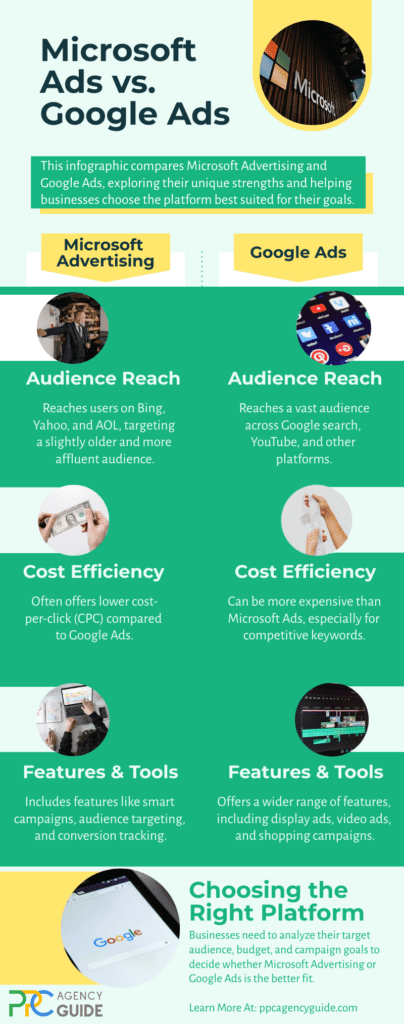Every marketer worth their salt is aware of Google Ads, yet many miss Microsoft Ads (previously Bing Ads) and its unique user network. An estimated 47 million people rely entirely on the Microsoft Search Network. That’s 47 million potential consumers you’re missing out on by only using Google Ads. Furthermore, because Microsoft Ads aren’t as well-known, competition for keywords and viewers is lower. When compared to Google Ads, this means that costs are lower, and your marketing expenditures can potentially go further.
What is Microsoft Advertising? (Formerly Bing Ads)
Microsoft Ads, formerly known as Bing Ads, is Microsoft’s self-service advertising platform, that enables advertisers to create campaigns and target customers across Microsoft’s Search and Audience Network. Microsoft’s search network (which includes partners such as AOL and Yahoo) accounted for 37% of all PC searches in the United States in 2019. In addition, like Google, Microsoft has made significant progress in enhancing its AI and machine learning skills with features like Automated Extensions, Dynamic Search Ads, Automated Bidding Strategies, and others.
Key Differences Between Microsoft Advertising and Google Ads
Audience and Reach
Microsoft Advertising and Google Ads are powerful digital advertising platforms each offering unique benefits for advertisers. Understanding their differences can help businesses choose the best platform for their advertising campaigns and achieve a better return on investment (ROI).
Google Ads dominate the global search market, particularly on mobile devices. Microsoft Advertising, powered by Bing Search, Yahoo, and AOL, focuses on desktop traffic and attracts higher-income professionals. This makes Microsoft an excellent choice for businesses targeting niche or professional audiences, primarily via Bing Ads and search marketing.
Cost Efficiency
Microsoft Advertising often has lower competition, reducing pay-per-click (CPC) rates. This provides businesses with cost-effective opportunities to reach their audience while maintaining strong ROI. While Google Ads offer a broader reach, they generally require higher budgets due to greater competition for keywords.
Features and Tools
Microsoft Advertising includes tools like Dynamic Search Ads and BingAds Editor, which help manage campaigns efficiently. Google Ads integrates with platforms like Google Analytics and other digital advertising tools, giving it an edge in cross-platform strategies.

Businesses can capitalize on these differences by aligning campaign goals with each platform’s strengths to achieve their marketing objectives.
Microsoft Advertising Strategy & Optimization
When creating ads on any platform, you should focus on the right PPC metrics to ensure that the target audience goes down the marketing funnel after arriving at your landing page. Advertising networks constantly alter their platforms, such as Google eliminating expanded text ads and Facebook changing its brand to Meta. As a result, you must develop an ad optimization plan to build user trust in your business.
With the introduction of mobile-first indexing, you must concentrate on optimizing Microsoft Ads for mobile devices. Any PPC campaign must focus on ad optimization techniques to keep the user interested in your ad. You must ensure that users select your brand the next time they enter your company’s search terms or keywords.
Maximizing ROI with Microsoft Advertising Campaigns
Microsoft Advertising is a promising platform for cost-effective PPC advertising, offering tools that enhance campaign performance while maintaining budget efficiency.
Advantages of Microsoft Advertising:
- Automated Bidding Strategies: Features like Enhanced CPC and Target ROAS adjust bids dynamically to prioritize high-performing keywords, improving conversions while keeping costs low.
- Advanced Audience Targeting: Marketers can segment users based on demographics, interests, and behaviors, ensuring ads reach the most relevant audience.
- Ad Personalization: Microsoft Shopping and dynamic text insertion allow for tailored messaging, improving engagement and conversion rates.
Campaign Optimization Strategies:
- Clear Calls to Action: Use action-driven messaging like “Buy Now” or “Get Started” to encourage conversions.
- High-Quality Ad Creatives: Engaging visuals and compelling copy help capture audience attention.
- Data-Driven Bid Adjustments: Monitor and adjust bids based on performance metrics to maximize ad efficiency.
Performance Tracking for ROI Optimization:
Tracking key performance indicators (KPIs) helps businesses refine their digital marketing strategies:
- Click-Through Rate (CTR): Measure engagement and optimize ad copy accordingly.
- Conversion Rate: Track how effectively ads turn clicks into leads or sales.
- Ad Spend Efficiency: Ensure budgets are allocated to the highest-performing ads.
Utilizing Microsoft Advertising’s reporting tools enables businesses to fine-tune campaigns, allocate budgets effectively, and sustain long-term success in the competitive digital landscape.
Microsoft Advertising Automation
Microsoft Advertising simplifies online advertising through automation, enabling marketers to run optimized campaigns with minimal manual effort. Automated rules allow businesses to control ad spend, schedule campaigns, and adjust performance in real-time.
For example, advertisers can set a daily budget and automate bid adjustments based on performance. If an ad campaign generates high conversions at a low cost-per-click, the system can automatically increase the budget. Conversely, if performance drops, Microsoft Advertising can reduce bids to prevent overspending. Automation also ensures ads appear at the best times, maximizing audience engagement and ad visibility.
Microsoft Advertising also enables seamless campaign management by allowing businesses to import Google Ads campaigns, making it easier for marketers already using Google’s platform to expand their reach. Additionally, Microsoft Advertising support provides tools for monitoring campaign performance, ensuring advertisers can make data-driven decisions to improve results.
By leveraging Microsoft Advertising automation, businesses can enhance their PPC strategy, gain better visibility in the search engine market, and optimize advertising goals effectively. Whether running ads on Microsoft Shopping, Bing Search, or display networks, automation ensures peak performance, delivering a strong return on investment and higher conversions.
Conclusion
Disregarding Bing in favor of Google may appear to be a good move at the time, but it may harm your business in the long run. While Bing isn’t everyone’s preferred search engine, it does have a dedicated user base, and ignoring Bing in your marketing means you’re missing out on marketing to these consumers.
Frequently Asked Questions, Answered
How does the Microsoft Search Network differ from Microsoft Advertising?
Bing and associated sites comprise the Microsoft Search Network. It’s where your company may reach a vast and distinct audience of millions of people who search every day. Connect with these valuable potential clients by using the advertising platform: Microsoft Advertising.
What is the Microsoft Search Network?
Microsoft Search Network is a part of your consumers’ life, powering the devices, apps, and websites they use every day and meeting them where they need it most.
Where do my Microsoft Ads appear?
Your advertisements could be displayed at the top or bottom of Bing, Yahoo, and MSN search results. You can also target your adverts based on geographic regions, times of day or week, and even demographics.
How Can I Personalize and Manage Microsoft Ads for Better Engagement?
Microsoft Advertising provides versatile tools to personalize your campaigns and improve ad management while respecting user privacy. By adjusting ad settings and using advanced audience targeting options, businesses can tailor their ads to specific demographics and behaviors, delivering messages that resonate deeply. Features like dynamic ads allow advertisers to craft engaging messages that improve click-through rates, whether users browse through Microsoft Edge or alternative browsers like DuckDuckGo.

















